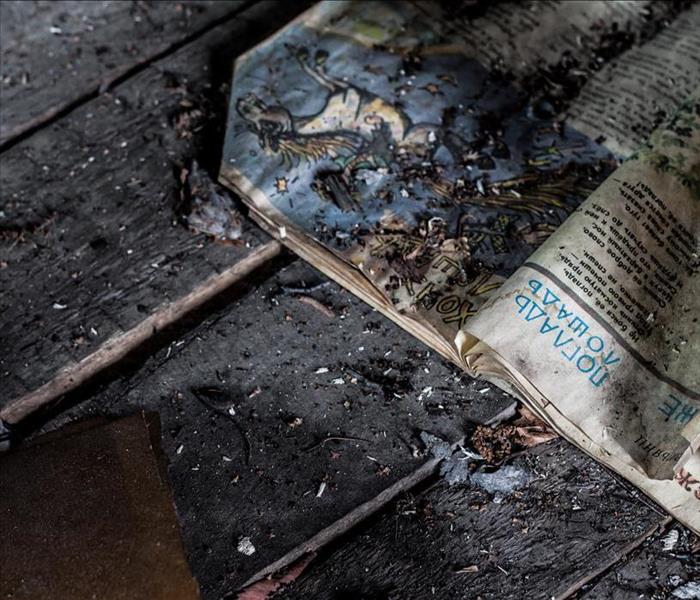How To Effectively Clean Grimy Soot Off 3 Different Surfaces
11/30/2020 (Permalink)
For most varieties, leave cleaning soot to smoke restoration professionals.
Cleaning soot is not as easy as wiping the dust off your house’s furniture.
If you don’t use the suitable equipment and the right method for cleaning soot, you’ll end up with a bigger mess on your hands. Not everyone has access to a vacuum with a HEPA filter or other high-powered electronic devices needed to repair smoke damage!
Soot that emits from rubber and plastic combustion is oily in texture and is not easy to clean with household cleaning equipment.
Moreover, soot stains in the kitchen result from protein burnout, making them the most stubborn soot stains. Call the soot cleaning professionals for repairs if you don’t want your house to emit toxic fumes and particles long after being damaged in a fire.
What is soot?
Soot is the impure carbon particles resulting from incomplete combustion of hydrocarbons like wood, oil, and charcoal. When organic matter burns, it releases the residue of its pyrolyzed fuel in the air, which is either brown or black.
They are a type of pollutant that is sticky to touch and can get smudged easily upon contact on any surface.
These particles get stuck on different surfaces like walls, fans, ventilators, and chimneys and can cause various complications–especially in people with respiratory issues like asthma.
What surfaces can soot stick to?
Different types of soot stick to various surfaces and require specific cleaning protocols. For example, dry soot is like dust that settles on furniture, whereas wet soot–moisture mixed with dry soot–can easily stick to any surface.
Among all soot types, dry soot is the easiest to clean. The other classes (wet soot, oily soot, protein soot) often require hiring professional help.
You can try cleaning the other types of soot on your own; professionals do the task in a fraction of the time.
Cleaning soot from painted walls
Find a clean cloth and dab rubbing alcohol or paint thinner on it. Then, gently rub it against soot stains on the painted walls.
Cleaning soot from painted walls is the easiest of all available options, especially if the paint used is stain-resistant. A chemical dry-cleaning sponge will be able to do the same job as well.
In some cases, using a wet cloth on the walls smudges the carbon particles over the surface. Soot particles are soft to touch, but their texture is sticky; therefore, direct use of a wetted cloth for cleaning can create a mud-like mess on your wall.
If you find yourself in a similar situation, try cleaning it using a dry-cleaning sponge first, then use something wet to clean the remaining residue.
Cleaning soot from brick fireplace
Fireplaces don’t pose an immediate danger to you and your family, but if you don’t clean them regularly, they can malfunction, depositing soot in the surrounding area.
For their cleaning soot from fireplaces malfunction: first, remove ashes from the hearth, then sweep off debris and dust particles from the area as much as possible. Then, clean the difficult places using a long brush. Don’t forget the nooks and crannies!
The final step uses either a mixture of water and vinegar or a paste of baking soda and dish detergent to scrub the soot off the interior of your fireplace. You might need to do a fair amount of scrubbing, but that’s the downside of not hiring a professional–SERVPRO’s team is up to the task if you need support!
Cleaning soot from stone
The most efficient way of cleaning soot from stone surfaces is with TSP (trisodium phosphate), which you can buy in either liquid or powder form from the market. The product is toxic if ingested, and direct exposure can irritate your skin and eyes.
Cleaning soot from concrete floor
Not many products can clean soot from concrete floors, especially in cases of extreme smoke damage. If you want to give it a try, use grill cleaners; many people have attested that it works if you rub the surface long enough.
Call soot cleaning professionals!
Most of the cleaning methods mentioned above require careful handling. If you are doing it yourself, use gloves, goggles, and cover other cleaned surfaces with a tarp before staring at your soot cleaning task since the methods described can be harmful.
Cleaning soot stains in your kitchen are possible without any professional help, but things like a fireplace cleaning or smoke damage clean up requires professional restoration. We advise you to always go for the most comprehensive solution for your home instead of the cheapest.
Some smoke damages are beyond repair–only a professional restoration crew can bring these surfaces back to life. You don’t need to strain your body and risk your health for an impossible cleaning task–leave it to the professionals!
Call us at (706) 896-1880






 24/7 Emergency Service
24/7 Emergency Service
